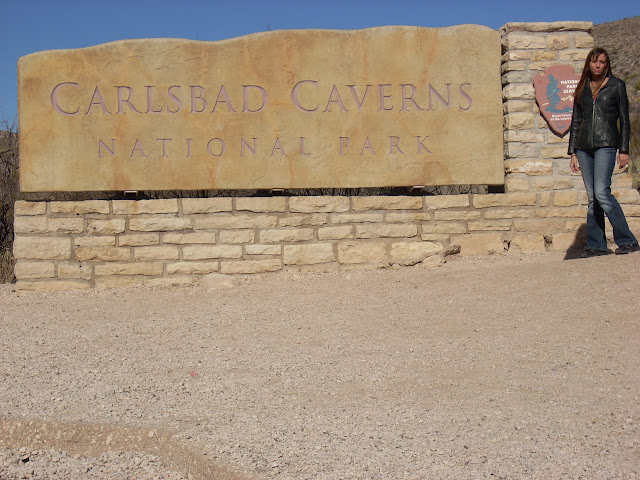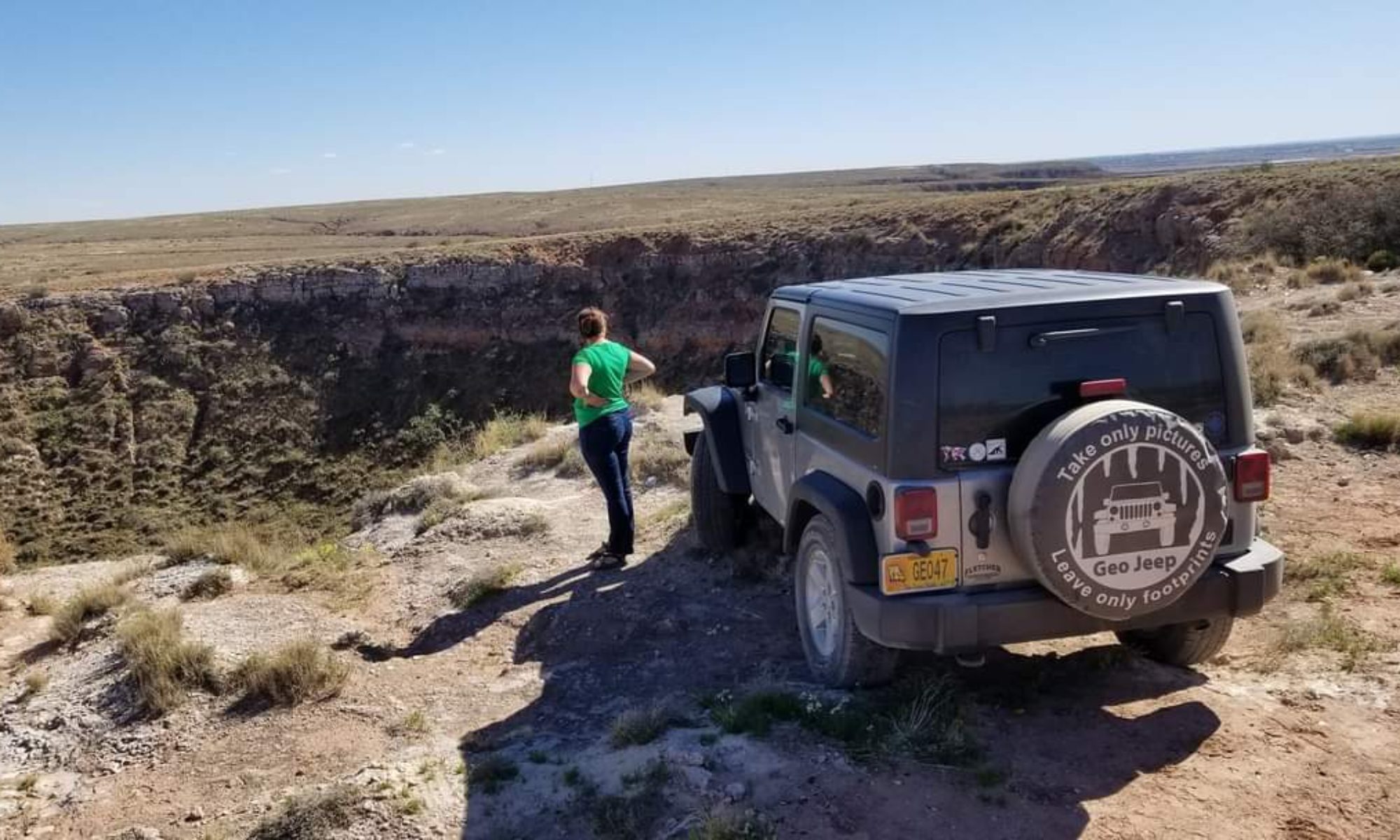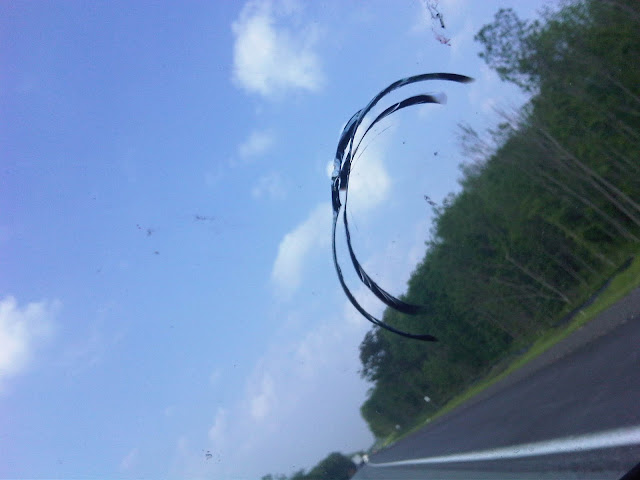I’m in love. Have I told you that? I could live there and still not be satisfied with my time spent. That’s right, I’m in love with Carlsbad Caverns.

After my last entry I went to eat breakfast at Denny’s since I had waken up too late for the free breakfast the hotel provides. I ate my food so fast I think the waitress, and a couple of the other diners, were astonished. I must have looked starved but I didn’t care- I was in a hurry to get to Carlsbad Caverns.
Carlsbad Caverns is about a 20 mile drive west from the city of Carlsbad. When you reach the sign proclaiming “Carlsbad Caverns” you still have another 6 miles to drive. I stopped to take a few pictures in front of the sign, a couple with my digital and one with my phone. When you are traveling alone it is always interesting to get pictures of yourself on your travels. For safety reasons I usually prefer to wit until I am alone, which doesn’t seem to be a problem in most areas, then find a safe spot to sit my camera and set it on a 10 sec delay to give me time to get into position. Most of the time in these situations I use the hood or roof of my car, and this time was no different. I took a few pictures with the digital. As another car approached the pull-off I finished my last picture and jumped back in the car.
A lady and her son get out to take a picture by the sign. On the way up to the sign she suddenly jumps in front of my car as I start to pull out.
“Wait! Wait!” she cries, waving her arms.
I stop and open the door (my Dodge Stealth’s drivers side window doesn’t work) and she picks my camera up off the hood of my car and hands it to me.
“You don’t want to lose this do you?” She laughs.
I thank her over and over. I ask if she wants me to take a picture of her son and herself but she says no thanks. This makes the second time I was saved by a complete stranger in the past few days. I think a trend is starting to develop.
I pull up to the visitor center in Carlsbad Caverns National Park, which sits perched on top of a small mountain, and took notice of a sign as I pulled up. “Absolutely NO pets left in vehicles or allowed in caverns. Must use available kennel”. I hope this isn’t going to be too expensive…
I see a lady leaving the visitor center and I ask her about the kennel. She says it looks like it is a good place, and that it costs $5 for the day. Not bad. This is going to make my day much easier!
After picking out a kennel for Ellie and providing her with a fresh bowl of water I wander into the visitor center to purchase my tickets. I had REALLY wanted to go on a wild caving tour, but when I went to purchase tickets two weeks ahead of time online they were already sold out for this day. I was hoping for a cancellation or two when I arrived but there was no such luck. The only tour available was of course the self-guided main tour that takes you through the natural entrance, descending over 750’ and the winding through 1.25 mi of pathways until you reach the Big Room pathways. The Big Room, which includes the Hall of Giants, is quite literally a BIG ROOM full to the brim with gorgeous speleothems of all sorts. Over 6 football fields could fit inside this cavern area. Now THAT is big. This tour only costs $6, and is full to the brim with exciting things to see of the underworld. I HIGHLY recommend going on this tour. It will certainly be the best $6 you’ve ever spent!
I paid for my ticket and headed down the pathway towards the gate where a park ranger gives you a drill down of what you can and cannot do. No food or drink allowed in the gave, this includes gum. Kids must stay within arm’s length of their guardian. Absolutely NO TOUCHING of the formations. (For those of you unfamiliar with a cave’s natural state, touching the formations can actually kill them. The oils from your hands stop the water/mineral mixture from adhering to the rocks surface and it stops growing.) Then, a handful of people at a time, the release you into the pathway that descends past the bat watching auditorium and into the great underground.
As I walk past the bleachers that are there for the bat fly-out I remind myself I must return in the spring to see this. Every night from about March thru October thousands of bat swirl out of the cave into the darkening sky to feed on mosquitoes and other annoying bugs. Every night they take the exact same path, and have been doing so for years and years.

The descent into the cave is a pretty nice walk. The pathways are very rough, like a chunkier sandpaper, so that you don’t slip walking down the steep grade. Each time you turn the path you can feel the air of the cave hit your face. It’s a familiar feeling for me and I absolutely love the scent that accompanies it. The air is slightly cool, but only because it is damp. The smell is a damp, earthy tone that reminds me of several things from my childhood that I enjoyed. For example, The “Fire in the Hole” underground rollercoaster that sprays water on you at Silver Dollar City (Branson, MO) has a similar scent. Anytime I am in a cave I breathe it in deeply and let it calm my senses.

The tour of the cave itself is hard to explain except in pictures, and I took plenty (over 230 of them). Every time I turned a corner I would think that certainly it would end soon. Nothing so wonderful could last that long. But turn after turn I was further amazed at the increasing prevalence of speleothems and the opening of the rooms into larger and larger ones. It was almost too much to take in.
 In fact, I had to sit down on a bench after I passed the Hall of Giants. I was so happy, and the caves were so much to take in, I almost started crying. I fought with myself, sitting there in that beautiful underworld. I am NOT an emotional little girl, I told myself. I don’t cry when I am overly happy, it just doesn’t happen. I fidgeted with my camera, pretending to mess with the settings and furrowing my brow in frustration of my sudden emotional turn. An Indian man approached me and asked me if I needed someone to take my pictures. I smiled and used it as an excuse to shove away these emotions and handed him my camera. He took a picture, of which I am not sure I will post because I look a little out of it, and then I continued along my way.
In fact, I had to sit down on a bench after I passed the Hall of Giants. I was so happy, and the caves were so much to take in, I almost started crying. I fought with myself, sitting there in that beautiful underworld. I am NOT an emotional little girl, I told myself. I don’t cry when I am overly happy, it just doesn’t happen. I fidgeted with my camera, pretending to mess with the settings and furrowing my brow in frustration of my sudden emotional turn. An Indian man approached me and asked me if I needed someone to take my pictures. I smiled and used it as an excuse to shove away these emotions and handed him my camera. He took a picture, of which I am not sure I will post because I look a little out of it, and then I continued along my way.
I also came across a really nice park ranger along my travels in the caverns. She works at Carlsbad Caverns for 6 months, then travels up to a Colorado State Park and works there for another 6 months. We talked about caves for a while, and she told me about some friends she has that work at Mammoth Cave in Kentucky and the research they get to help out with. I told her about “The Longest Cave” and encouraged her to read it, and showed her some pictures I had on my phone of bats in Missouri caves. She gave me some information on how I could get a job working for one of the National Park caves. I stored it in my phone. This was certainly something to SERIOUSLY consider.
When I finally reached the end of the tour, where a large series of elevators take you up through the rock (with windows on all sides so you can watch the rock fly past you), I was again feeling that sweeping emotion. I walked into the bookstore, which uses all it’s profits for cave conservation, and concentrated on getting some souvenirs and post cards. While sitting in front of the post cards staring at them but not seeing them a man I had met earlier in the caves approached me and asked me if I had enjoyed the tour. I chatted with him a while, he said he could tell I was a caver by my gear. (I had brought in my adventure bag, which is stained from cave mud and had a small led flashlight attached to the zipper). He told me about some caves from where he lives back in Texas and told me it’d definitely be something worth seeing. He introduced himself as Victor and said it was nice meeting me, I shook his hand and gave him my first name as well and he left with his family.

I ended up purchasing a book and a t-shirt, and a few postcards. The t-shirt I am in love with. It is made out of bamboo, so it is environmentally friendly, and has Carlsbad Caverns in beautiful script down my left side. I picked up Ellie, who was soaking wet from being in her water bowl, and we left the top of the mountain.

On the way down the winding roads we stopped at one of the trails and walked to the end where there was a wonderful outlook over the canyons. Ellie got plenty of exercise, and we both enjoyed the warmth of the sun after spending the  previous day in a winter wonderland. The sun was nearing it’s position for set and I decided to head back to the hotel which was about 20 minutes away.
previous day in a winter wonderland. The sun was nearing it’s position for set and I decided to head back to the hotel which was about 20 minutes away.
I decided that since I was in New Mexico the dinner of choice should be some authentic Mexican. I headed into town and discovered that since it was Sunday the couple shacks I had seen along the main drive were closed. I decided to use my borrowed GPS to locate a Mexican restaurant.
Here’s the time to explain the characteristics of the GPS I borrowed for this trip. It is older, and when you plug it into your cigarette lighter outlet it takes several minutes, sometimes up to 10 or 15, to warm up and figure out where you are. It also has a very sensitive power cable that if you touch the wrong way restarts the unit, and you have to wait again for it to find where you are. It is also a little out of date with the information in it. After the GPS warmed up I followed it to a couple places that were closed, and the final attempt at finding a restaurant ended at an empty grass lot.
Much less to say, and a little amusing, I ended up getting Taco Bell.
It was a wonderful day and I will certainly treasure these experiences for a lifetime. Tomorrow I continue my journey to another land, I will be driving almost 1000 miles to the west, back to my birthplace.
GEOLOGIC NOTES:

In this blog I use speleothem and formation interchangeably. Formation is not necessarily an appropriate term for a speleothem, but it is used widely to describe stalactites, stalagmites, soda straws, cave pearls, cave popcorn and more. If you want to get technical, these definitions are:
SPELEOTHEM:
any of the crystalline deposits that form in a solution cave after the creation of the cave itself. These deposits are generally composed of calcium carbonate dissolved from the surrounding limestone by groundwater. Carbon dioxide carried in the water is released as the water encounters the cave air; this reduces the water’s capacity to hold calcite in solution and causes the calcite to be deposited. These deposits may accumulate to form stalactites, stalagmites, flowstone, helictites, cave pearls, and many other formations. Deposits formed along ceiling cracks may produce drip curtains or draperies that may then reach the floor to become walls. Speleothems may grow in pools to form the nodular encrustations of cave coral or the natural dams that continually elevate themselves through accretion of calcite. The pure white of the calcium carbonate is often tinted with hues of red, yellow, and gray and may even be translucent. The growth rate of speleothems is highly variable due to seasonal variations in the rate of flow, carbon dioxide content, and other factors. Caves owe most of their beauty and much of their interest to these secondary growths.
FORMATION:
| 5. |
geology |
|
a. the fundamental lithostratigraphic unit |
|
b. a series of rocks with certain characteristics in common. |
I would also like to add some information about Carlsbad Caverns versus the caves I usually visit in the limestone beds of Missouri. You may notice that most caves are carved out of water, and tend to have a long, linear shape to them as the groundwater travels in a stream or certain direction. After the limestone, or other soluable rock formation, is dissolved, the deposit of speleothems can begin. As the groundwater continues to trickly through the bedrock and it reaches the cave the water is enriched in minerals that get redeposited on the walls, ceilings, floor, etc of the cave. This is how a speleothem is, generally, formed.
Carlsbad Caverns has a very large and open nature to each of their rooms, and while the speleothems in Carlsad Caverns are formed in the same manner as above, the cave itself formed in a different manner than many of the caves we visit in the midwest.
Somewhere between 4 and 6 million years ago, water that was rich in hydrogen-sulfide mixed with other rainwaters to form sulfuric acid. It is this acid that allowed the caverns to form in large, magnificent rooms rather than long, lineated passages like those we are so familiar with.
For more information about this, I highly recommend visiting the National Park Service’s website on Carlsbad Caverns, particularly this page:
http://www.nps.gov/cave/naturescience/cave.htm









